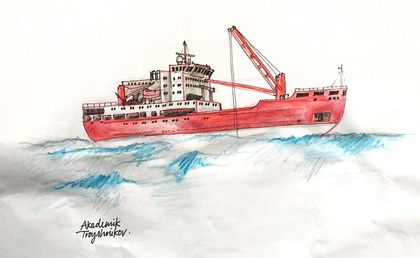ROV expedition to deep water canyons off Western Australia 2020 #NingalooCanyons
Very few deep sea areas both in and outside of Australia have been well-sampled over large spatial and temporal scales, and a large number of species still remain undiscovered and unnamed. We partnered with the Schmidt Ocean Institute and used the RV Falkor and ROV SuBastian to explore the canyons near Ningaloo. We aimed to identify and characterize the benthic biodiversity in Cape Range and Cloates Canyons and complement ROV surveys using environmental genetics (eDNA). Since we usually have little opportunity to explore the deep sea with a dedicated science ROV, this expedition will have a major impact in understanding this deep sea region. See here for the expedition website, blogs and imagery, and use the hashtag on Youtube to view all the underwater footage.
Antarctic Circumnavigation Expedition- 2016-17
We completed a journey with over 50 researchers from 30 countries to complete the first scientific circumnavigation of Antarctica! Our project focused on whether sub-Antarctic islands have provided a refuge in previous glaciation periods. If so, these areas might hold special significance in relation to genetic diversity or unique biological attributes (chemistry, host-symbiont relationships). And that might make them places we want to focus conservation efforts on in a time of changing climate. See here for a recent news article about the ACE and stay tuned for more news!
Read about the expedition or the embedded journalist's experience on the cruise. You can also follow the expedition on Facebook.
Read about the expedition or the embedded journalist's experience on the cruise. You can also follow the expedition on Facebook.
Women of Antarctica Wikibomb- 2016
We thought that Antarctic women researchers often didn't get the recognition that they deserved. And it has long been recognised that the gender imbalance on Wikipedia is a problem. So we did something about it. And launched a Wikibomb at the Scientific Committee on Antarctic Research Open Science Conference in Malaysia. Over 350 people attended the event, and we launched over 100 wiki pages celebrating the achievements of Antarctic women researchers.
Name the Nudibranch competition- 2016

Listen to the radio program where we introduced the nudbranch naming competition
And one of the news articles summarising the idea
And an article explaining why we bother naming species at all
And one of the news articles summarising the idea
And an article explaining why we bother naming species at all

Follow our 2016 Ruby Seadragon Expedition!

Scotia Arc expeditions 2011 & 2013
These expeditions took us on a journey along the Scotia Arc- the series of islands and ridges that track where Antarctica and South America used to join.
This research aimed to understand whether animals also use these places as a series of ‘stepping stones’ to travel between these continents. Our earlier expedition (in 2011) featured in the Australian Museum’s Deep Oceans exhibition.
We sampled invertebrate animals and will use the power of DNA to estimate how far these animals travel. This will help us determine if their movement patterns change in the future, when Antarctica might be a little warmer and a little different. Will we be able to detect new animals moving into Antarctica for the first time?
If you are curious, check out the full blog for the 2013 expedition.
These expeditions took us on a journey along the Scotia Arc- the series of islands and ridges that track where Antarctica and South America used to join.
This research aimed to understand whether animals also use these places as a series of ‘stepping stones’ to travel between these continents. Our earlier expedition (in 2011) featured in the Australian Museum’s Deep Oceans exhibition.
We sampled invertebrate animals and will use the power of DNA to estimate how far these animals travel. This will help us determine if their movement patterns change in the future, when Antarctica might be a little warmer and a little different. Will we be able to detect new animals moving into Antarctica for the first time?
If you are curious, check out the full blog for the 2013 expedition.
Scotia Arc outreach activities
Part of our research efforts in the Scotia Arc were used to develop high school teaching resources around San Diego. The CREATE STEM success focuses on teachers' professional development, and creating linkages between scientists and teachers. As part of the Scripps Educational Alliance, teachers could interact directly with us, and develop teaching plans to aid other teachers, and enthuse students throughout the region. Next Generation Teaching Standards have a heavy emphasis on teaching students the process of doing science, and we were delighted that our project touched upon many areas for teaching development. See here for the resulting CREATE blog, and for the lesson materials.







